Outside its chilled down big time. We’ve had a long sweet summer but the turn is on and we all have to prepare for the immediate vicissitudes of winter let alone oncoming global climate change. And damn can things change quickly and dramatically on all sorts of fronts, home, work, community. The big one for me is that my daughter Kaylene is seriously ill, although improving. I’ll tell you more about that later. But also there are issues in the field and community and my teams are facing big challenges; programmes going through speed bumps, personality clashes, conflicts between the values we espouse and what we actually do in practice. Ah, it’s the stuff of life, and death, and it is why we get up in the morning – until we no longer can.

Anyway, let me tell you some stories before they pass me by. We’ll start where I last left off, planning for Paddy’s Day. St Patrick’s Day is its own global phenomenon and is a testament to the both the cultural morphing that results from globalisation and a paradoxical flip side that reaffirms uniqueness and creates something tasty in the global market The roots of our contemporary St Paddy’s celebrations go back neither to Dublin nor the Derry but to the streets of New York. The Irish Diaspora delivered its human cargo to Aotearoa as well as to North America, and our St Patrick’s Day traditions have developed much along the lines of New York with parades and much singing and dancing and here, getting drunk in that special manner of bingeing that Kiwis call ‘on the piss’. To me, it’s been very much about harking back to the auld country and I’ve had enough of it. I’m of Irish stock, and proudly so, but I don’t want my Irishness to be forever drunk and looking backwards, I want it to be expressed in the here, Aotearoa, and in the here and now, 2007 and beyond. I want my Irishness to be a contribution to this land, to this nation. If that’s the case then it better have a relationship with the people of the land, my Treaty partners. So for me, to be a valid Kiwi celebration St Paddy’s Day in Aotearoa has to have a connection with Maori, these Gael-like tribes of the South Pacific who hold the indigenous cultural custody of Godzone.
There’s a line or two of Hemi’s poetry that goes:
In this fair green land
Where He and we go hand in hand
Simply by being who we are
And following the Maori star
Besides following the Maori Star and enjoying a sense of partnership with the roots of the land the notion of ‘simply being who we are’ brings a twinkle to my eye. And perhaps it was the same twinkle that appealed to (Sir) Tipene O’Regan and (His Excellency, Hon) Anand Satyanand when they accepted my invitation to speak at the inaugural Hui & Huilli held last month at Waiohiki. We’ve used the old Gaelic form of Huilli rather than the English Hooley because Huilli contains ‘hui’. Te Rangihiroa – Sir Peter Buck – held that there were old connections between the languages. In any case the idea was to pay respect to the twin streams that contribute to the cultural flow of our land – I say ‘twin’ because I promote a bicultural perspective (Tangata Whenua/Tangata Tiriti) whilst readily conceding that there is a multi-cultural hue to the Tangata Tiriti stream.
To push the point we’d developed a day-long St Patrick’s programme based around music, whanau storytelling, and Maori Celtic art. I must have been dizzy, mildly pissed maybe, when I thought up the idea of a holding a church service at 9.00am on a Saturday to start the day off. It’s the right thing to do of course, karakia and all that, but I was obviously overly optimistic in believing that people cared a damn. Unless you’re an Adventist Saturday-morning-church is just not a big crowd pleaser (call it rugby then), and so when it came time to kick off the congregation consisted of only Fr Don Hamilton, the lead celebrant, Hamuera, our local Ratana Silver Band, our kaumatua Heitia Hiha and his wife Margaret, whanau members who I had cajoled into attending, a few friends, and members of the Arts Village.
Let me tell you about the Hamuera Ratana Silver Band. Hamuera (Samuel) was the third son of T W Ratana (Alpha and Omega being his older brothers). It is said that when T W Ratana broke tapu – as he was wont to do, one of his tasks being the ‘annihilation of tohungaism’ – Hamuera would break out in skin rashes, boils and carbuncles. So this our local band’s name, Hamuera. And it raises an interesting issue not often spoken about here at Waiohiki; the tohunga traditions of our kainga. You’ll understand the current significance of tohunga for my immediate whanau later in the story, but what I’m referring to here are those ancient taputapu capacities that are held by the Tareha line. Not only did T.W. Ratana rale against these ancient practices but they were also suppressed by New Zealand Law. But an ancient and sacred capacity doesn’t just fade away, and whilst the people may well have been keen to see the evil arts of makutu and associated witchcraft pass into oblivion they wanted to keep a firm grip on the healing arts that were the essential thrust of the tohunga role. In many instances at a whanau level spiritual beliefs were transferred into an alternative channel, the Christian ‘hahi’, Anglican, Roman Catholic, Jehovah’s Witness and Mormon. Those following Ratana contextualised their essentially Christian kaupapa into a Maori agenda, and like Ringatu, a millennial movement. In many cases new beliefs created irreconcilable and bitter rifts within and amongst whanau and these tensions still prevail to a lesser extent today. On the other hand understanding and conceptualisation of the spiritual dimension has shifted, perhaps grown. Contemporary theology is inclusive of many understandings of God. This is consistent with the augmented thinking that is described as ‘transdisciplinarity’ or ‘Mode 2’ knowldege. And so with increased understanding, indigenous beliefs and knowledge, once considered to be pagan and evil, are increasingly acknowledged in terms of their own contribution to ‘ora’. And what has resulted is a sort of ambidexterity, an ecumenism, reflected in the fact that the Hamuera Bandmaster, the aforermentioned Stephen Pene, with indecipherable commands, is himself a mokopuna of Tareha.
The Ratana Silver Bands are a fusion of the traditions of the European silver and brass bands and a Maori millennial movement. There are six Ratana bands (besides Hamuera, there are Arepa, Omeka, Piriwiritua, Tuatoru, and Nga Tuahine ) and they are a key element of regular Ratana church services in their own areas and the annual hui held at Ratana (25 January each year).

Hamuera Band Member 'Rusty' came down from Te Wairoa.
On this St Patrick’s Day ‘Hui & Huilli’ Hamuera’s role was to play at the church service and to ‘march-on’ the Governor General Anand Satyanand. I’d hit His Excellency up at the NZ Rugby League Annual Prizegiving and he’d agreed to come to our do. Of course there’s rigmarole to go through with Government House and everything has to be locked down and specified to ensure clarity or role and to avoid any complications or risk of embarrassment. We did our best to plan the work and work the plan but I’ve got to admit that when the gig really cranked up and unexpected things happened we just made it up as it came at us. In any case Anand arrived in a suitable vehicle accompanied by his lovely lady, Her Excellency, Helen Satyanand, a smartly dressed aide, and Dave Stone the Crown’s local cultural advisor. Two plainclothed diplomatic security police hovered in the shadows.
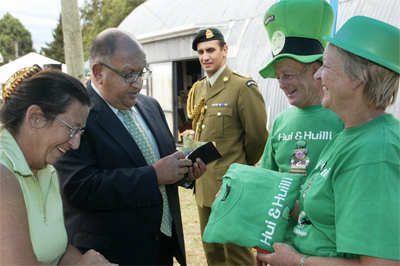
From left: Lynn Pratt, Anand Satyanand, Ross and Ngaire Duncan.
Sir Tipene had not long finished a long and hilarious recounting of his whanau history with the liaison between his Maori kuia and his Irish ancestor O’Regan. O’Regan takes his wife back to the emerald isle whereat the lady encounters kith and kin. We Irish were not particularly couth. She was unimpressed, and save the odd and noted exception considered us Pakeha to be in general ‘taurekareka’. Tipene mimicked the rattling of her teeth as she pronounced this highly insulting word, and the onomatopoeia of the humour crossed the language divide and foregave any hurt intended or otherwise. It was great, and others took up the cross cultural challenge. Moana Keefe sang in fine voice, Daniel Munroe made Irish Rambler sound haunting and soft, An Irishman with a German surname, Trevor Rynhart, crooned popular old Irish melodies, hangi was served, the Guinness started to flow and the gig began to jig.
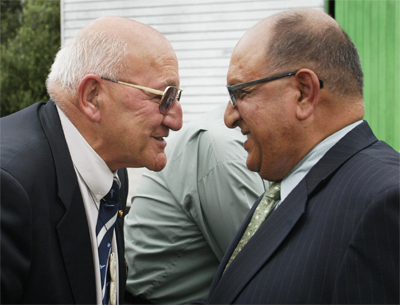
Sir Tipene O'Regan and Anand Satyanand.
And then it was the time to bring on Anand as the Governor General. Steven Pene, the bandmaster of Hamuera, blew his whistle, shouted indecipherable commands and the whole thing fired up a notch. Hamuera, I can advise, do not fit the typical profile, physical or demographic, of a silver band. They are mixed according to who is available, and everyone has a role and instrument to play. It is, I expect, much how village cricket teams were once convened, and participation is the key driver. The official party followed in the wake of this unusual assemblage of musicians and, on cue, the band parted like the Red Sea, and whilst Mr and Mrs Governor General and the other members of the official party bore no resemblance to Moses and the Israelites they nevertheless advanced through the honour guard of Nga Morehu to take their place on the waiting seating.
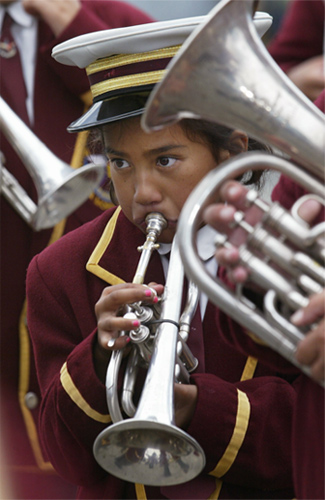
Hamuera's Chantal Henry with instrument and role to play. Courtesy of Hawkes Bay Today
Heitia Hiha is one of our kaumatua for Te Whanganui a Orotu and the collective of the seven ancestral hapu. He is a fine looking man, now in his seventies, and like many Maori of his age demonstrates superb command of spoken English in its classic form as well as beautiful use of Maori. Have you ever noticed how Maori can bring lyricism and poetry to our language yet we are grudging and clumsy in our use of their language? As is the form Heitia welcomed Anand who, in turn, replied.
Anand gave two speeches to us this day. Both were nation building. In this first korero he spoke of Tangata Tiriti as immigrants to new and far lands, his own whanau’s passage from India to Fiji, the intervention of WWII, their settlement in New Zealand and, in a testament to our Kiwi philosophy of meritocracy, his own journey as a NZ born Fiji Indian to the highest office in the land. Later, in the evening, at the Ceili & Kai, he spoke again. I’ll report on that shortly.
By this time of the day it was now time to swing into the Maori Celtic Art Auction. We had some fantastic art work including framed photographs by this site’s own Brian Sweeney. Chris Tremain acted as auctioneer and, for a first time event, the sales were good both in number and value. The Mad Butcher and local businessman Pat Benson had left significant bids on major works and this kept prices strong. We still have a few pieces on offer by the way, so if you want to be in have a look on http://waiohikiartsvillage.com/site/auction.html.
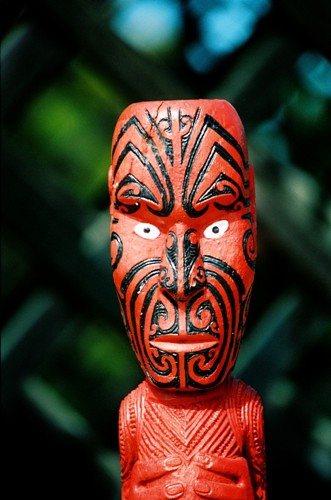
"Poutokomanawa", photograph by Brian Sweeney
With the Art Auction over we then had to quickly set up for the Ceili, shower, suit up and get ready for our guests – about 160 of them. Lion had donated some Guinness and some Bush Mills Whiskey. The Golf Club caterers had prepared delicious food. Our event team had decorated tables. We had a suite of musicians including John Mullaney, Anthony Mullaney, Moana Keefe, Shelley Pritchard, Daniel Munroe, Brannigan and his Kaapai Band, and the ubiquitous Frankie Stevens. The Governor General’s party arrived, Frankie sang the national anthem, welcoming speeches were made, Fr. Don said Grace and kai was served. During the week Ngahiwi Tomoana, the chairman of the tribe of Ngati Kahungunu, had organised divers to gather us crayfish, so we had this veritable feast on hand. The musos played in the background and wine, song, and good conversation flowed. Then, according to protocol (after dinner but prior to dessert), Frankie invited His Excellency Hon Anand Satyanand Governor General of New Zealand to give the inaugural St Patrick’s day address.
Anand reminded us that in Aotearoa we have begun to celebrate the broad range of cultural streams that feed us and advanced the emergence of the Diwali Festival of Lights – now a highlight on New Zealand’s festival calendar – as a case in point. He spoke of the strong and almost spiritual relationship between the Irish and Maori. Whilst the gene-pools may not be from the same source there are uncanny similarities between both cultures which have seen them build strong friendships and families in New Zealand. There are eerily similar characters and stories in Irish and Maori folklore. But, Anand told us, what is more striking is their shared journey.
“Both have faced more than a degree of hardship and oppression over many years. Both have had their traditions and culture threatened by assimilation. Yet, both cultures have returned to become strong and thriving”.
In Ireland, economic renewal has occurred hand in hand with the revival of Celtic traditions, language and culture. These traditions which stood Irish in good stead for so many Centuries, and which came so close to being lost, are now again celebrated and embraced. Here in Aotearoa Maori culture is also experiencing a similar renewal and a shared triumph over adversity. Anand said
“The continuing restoration of both cultures has occurred hand-in-hand with an economic revival in Ireland and New Zealand. And each of our countries is much the better for it”.
He said we are still in the throes of shaping who we are and we still have many challenges to over-come, but we are building an inclusive and open society which uses the best of all its parts. And he then showed a delightful grasp of local knowledge and adventures of previous occupants of the vice-regal household. He used a story about the game of golf to illustrate his point about cultural synergy. As I previously mentioned this second St Patrick’s Day speech was made at the Ceili & Kai and the venue for this was the Napier Golf Club, which is across the road from the Waiohiki Arts Village. Let the story be told in Anand’s own words.
“Golf – perhaps the most Scottish of all sports – has been embraced and mastered by Maori. Look no further than Michael Campbell and Phillip Tautarangi. You may know that Kurupo Tareha and his brother Te Roera helped set up one of New Zealand’s first golf clubs, Waiohiki Links, after his return from Queen Victoria’s 60th birthday in 1896. During that visit, Kurupo was taken to St Andrews and introduced to the game of golf -.a game he and his son subsequently excelled at. In an interesting twist, the last Governor-General to have visited Waiohiki Links, Lord Cobham, is said to have played a magnificent shot on the 18th. The late Audrey Mullany – herself a Tareha and wife to Irish jazz pianist John Mullany – was said to have congratulated him warmly upon his shot. So here we had an English Governor-General, playing the Scottish sport on a Maori golf course, being congratulated by the Maori wife of an Irish pianist. This is New Zealand.”
In leaving, this Governor General left us with a wero, a challenge, to continue celebrating who we are.
“We must rejoice in what makes us unique in this world. It is not a hard thing to do. There is much about being a New Zealander that is worth celebrating. But the key is finding ways to mark this celebration – often, and with passion.”
Damn, hows that! From the top: “celebrate who we are, party often, party hard!”
It was my duty and privilege to thank Anand, and to propose the St Patrick’s Day Toast. It was this. “To who we are” and the reply was “Kia ora begorrah”.
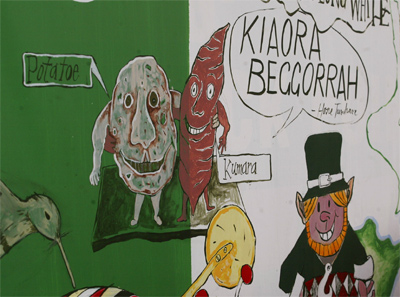
Folk art from Rose
The party started. Frankie turned on a show and half, and the people loved it. Brannigan and his Kaapai struck up and feet began tapping and then dancing. I imbibed and paid respect to our sponsor’s products. And then we were done. Brannigan and the boys were staying at home so after the gig we took the left over whiskey as prisoners and sat around the outside table and fire. The guitars came out and melodies ensued. Brannigan reckoned that the harmonies were now better than at the gig and did it mean that the boys had to be pissed to sound their best. Ah! The age old dilemma of the performing artist.
We’d organised to have breakfast with Sir Tipene. Due to a failure to take daylight saving into account he was in a right old funk by the time we arrived but he was soon in good enough humour and this improved as the clan gathered at Provedore our favourite eating house. Nick Rosenberg had been parked up at home too and he came along. Brother Nick, possessed of the intellectual capacity so obvious in his family, can be quite intense. He and Sir Tipene were soon in an erudite dialogue to which we, the Kaapai Band included, were a willing and appreciative audience. We had wit and wisdom, history, political analysis, and illustrative anecdotes. Nick proposed deep and perceptive questions. Tipene postulated, proposed, mulled, made witty asides and generally entertained in a way known to his forefathers but seldom seen or enjoyed in these days. It was great, and that’s the way we wanted it. The Hui & Huilli, in all its parts, raised about $10,000 for local community purposes. We’re intending to do it again. Book now.
Our daughter Kaylene has been ill. She’d rung her mom and said that she was feeling unwell. She’d gone off to the hospital a couple of times but they could find nothing apparently untoward and sent her home. Taape went down to help out with the kids (their paternal grandparents live nearby and are active angels of support) and she seemed to pick up. But no sooner had Taape come home to the Bay than our girl took a turn for the worse and was admitted. It was thought that she had suffered some form of stroke, but the condition seemed to have stabilised and medical staff were talking about rehabilitation programmes. However, despite being in medical care her condition began to deteriorate and a general admission turned to specialised attention in the intensive care unit. Late at night we were rung and asked to come to the hospital. The news was grim and not at all hopeful. I called for the priest and he soon arrived to deliver a blessing and, ominously, the last rites. We prayed. Taape wasn’t at all satisfied with my Pakehatanga Catholicism and demanded we locate a tohunga. Her father’s side are renowned for their healing skills and she started the firing up the contact network. This must have been about 3.00am. She couldn’t locate the cousin she was after, so I suggested that she turn to her mother’s side from the Wanganui River and we track down her relative Rangatihi (John) Tahuparae an acknowledged kaumtua and tohunga. Taape and I had been with John once when he performed the ritual blessing and tapu lifting on the new Korean Embassy in Wellington. As the tohunga went to enter the building two swirls of mist rose up either side of the doorway. It was extraordinary. The Koreans looked wide eyed at the Maori and I think even some of the Maori were stunned by what we had all just witnessed. The tohunga just nodded. Taape agreed that John should be asked for help. It was now in the time before dawn so I called his phone. The message system switched on and when I went to speak this huge wave of emotion swept over me and I could hardly get the words out. I managed to say, ‘brother, I need your help’ and left my number. As it turned out he was already in action performing his traditional duties and, when at dawn he received my message he and his lady Rose came to the hospital. Our priest Fr Orange dropped by. He looked a bit disconcerted when he saw John and learned of his tohunga status. I said “it’s ok Father. He comes from Jerusalem up the river and they are all Catholic tohunga there. Its and/and Father, not either/or. BC and AD. I’m sure the Lord will be all for it.”
John waited for the doctors to complete their duties and then listened as they reported back to us as to what was going on with our girl. No matter how it was cut she was fighting for her life, and the damage that had occurred was in a vital place. The doors to the intensive care unit opened and a small tribe of us gathered around her bed. As the karakia commenced I could almost feel the whanau tupuna, the old people, gather around us and respond to the invocations. It was powerful and affirming. John wound up with a ritualised statement to signify the end and we replied. He looked up and moving from ancient words to the contemporary Kiwi vernacular said ‘she’ll be right’. And, so it seems she may become. I’m still saying my rosary and throwing the odd bit of holy water, sinner though I may be. Taape and the rest of the whanau are saying karakia Maori. The doctors and consultants are applying the best of medical science. Kaylene is fighting and exerting her will to help her body heal and recover. It may well be a long haul, and, as I believe in the power of prayer, if you could take a moment to send her your prayers and wishes for good health I would be very grateful to you.
But, regardless of the hand that is played, we still have to keep the trains running. There’s lots I could and maybe should tell you about what’s happening in the prisons, and what’s doing down on the gang side of life but we’ll leave that for next time.
At Easter I went with my youngest son Laurie up the River to Jerusalem in part to thank the old people in person for the positive turn in Kaylene’s health and to support the hui being held to discuss the new book on James K Baxter and Nga Mokai.
The remnants of the first wave of Nga Mokai had gathered, called by John Newton to review manuscripts and photographs for an upcoming book. It was a gathering of apostles. Hemi used to be the ‘old man’ at 46 and now the key group members are all well past his use by date, but they are here as if in their youth gathered here at Hiruharama; Greg Chalmers, Eketahuna Jack (Doherty), Noddy, Paddy Black(Paddy Haira) and Paddy White (Patrick Ryan), Hohepa, Bungy, Fred, Chrissie, June Mackay. And there were the recorders and historians, John Newton and Ans Westra. Kathy had her tamariki and mokopuna, Miriam her son Lewis, and so too Carol Goodman and Charlie.
I want to go up the river road
Even by starlight or moonlight
Or no light at all, past the Parakino bridge,
Past Atene where the tarseal ends,
Past Koroniti where cattle run in a paddock,
Past Operiki, the pa that was never taken,Past Matahiwi, Ranana, till the last step is taken
And I can lie down at the end of the road
Like an old horse in his own paddock,
Among the tribe of Te Hau. Then my heart will be light
To be in the place where the hard road ends
And my soul can walk the rainbow bridge
That binds earth to sky.– Sestina of the River Road. James K Baxter
To an observer the way the hui rolls itself out parodies some of the old male leadership struggles of the commune and its warmly funny to watch. Gratefully a maternal direction is lent by Rae who maintains the ‘ahi kaa’ of the commune so that the event is something more than cultural tourism or a nostalgic foray by old hippies and socialists. After a powhiri we gather in Whiri-Taunoka and greet each other. It was great being amongst these community leaders who set a social agenda that I’ve followed much of my life. It was great too being there with my youngest, Laurie. He is of the local people, Ngati Haunui a Paparangi, through his maternal grandmother (Lucy Paetaha) and he also has a stake in Hemi’s kaupapa through his role as a manager of the Mokai Whanau Ora programme in Wellington. I have a sense of intergenerational transfer, and the drive back down the river to Wellington, though long and somewhat dangerous, leaves me with a sense of peace and preparedness to handle whatever the future holds.
Mauri ora! D.




















